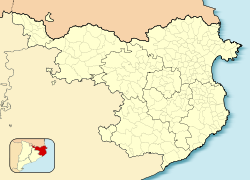|
Sant Feliu de Guíxols
Sant Feliu de Guíxols (Catalan pronunciation: [ˈsaɱ fəˈliw ðə ˈɣiʃuls]) is a municipality in the comarca of the Baix Empordà in Catalonia, Spain. It is situated on the Costa Brava and is an important port and tourist centre. The district abuts to the north, the upmarket s'Agaró resort built round the Sant Pol Beach. In addition to tourism and the port the cork industry is a traditionally local industry. The town contains a large monastery which now houses the town museum and is a protected historico-artistic monument. The C-253 road runs north near the coast from Sant Feliu de Guíxols to Platja d'Aro and Palamós, while the C-65 road runs inland from the town. The GI-682 provides a dramatic cliff top drive to Tossa de Mar to the south.[3] Sant Feliu de Guíxols is a staging point on the GR 92 long-distance footpath, which runs the length of the Mediterranean coast of Spain. Stage 9, to the north, closely follows the coast via S'Agaró, Platja d'Aro and Sant Antoni de Calonge to the next staging point at Palamós, a distance of 16.8 kilometres (10.4 mi). Stage 10, to the south, takes a largely inland route to the next staging point at Tossa de Mar, a distance of 20.2 kilometres (12.6 mi).[3][4] Geography and climate Located on the Mediterranean, the coastline of Sant Feliu de Guíxols spreads over ten kilometres (6.2 miles). It also includes many little bays with coves surrounded by pines with rocky or sand beaches. The beaches are cleaned daily[citation needed] and a modern water treatment system prevents wastewater from entering the sea.[citation needed] The town is engulfed by small mountains, with forests of pine, oak, and cork trees. Besides the town of Sant Feliu de Guíxols, the municipality includes the following localities:
EtymologyThe name Sant Feliu goes back to the martyred saint, Felix of Girona (d. August 31, 304), who came from Carthage in North Africa. Guíxols is a word derived from the former word iecsalis from a tenth-century document that mentions the monastery and seems to mean "rope-maker". History  An Iberian settlement was already present in the 5th century B.C. in the hill where the Salvament lies today. From the 1st century B.C. onwards, the population started moving to the plains surrounding the Riera de les Comes, where, in the Middle Ages, the Monestir de Sant Feliu de Guíxols was built. The settlement grew, and soon dwellings started to spring up on the other side of the watercourse, which would become the nucleus of the medieval town, centered on the market. Between 1892 and 1969, the town was connected to the city of Girona by the narrow gauge Sant Feliu de Guíxols–Girona railway. The line has since been converted into a greenway.[5][6] Monuments 
EventsSant Feliu de Guíxols is located in an area known for its parties, festivals and especially its carnivals.[citation needed] The Porta Ferrada International Festival, instituted in 1958, is celebrated in the town's port area. It involves theatre, music, and dance, and is usually celebrated in the summer. The Festa Major is a traditional, Catalan festival, celebrated on 1 August. It is dedicated to the town's patron saint, St. Feliu, and includes a large fireworks display that takes place on the beach.[8] Twin citiesSant Feliu de Guíxols is twinned with:
References
External links
|
||||||||||||||||||||||||||||||||||||||||||





